Design for planetary imaging and EAA & Lucky imaging!
Uranus-M and Uranus-C are not only used for planetary imaging, but are also very powerful for EAA and Lucky imaging!
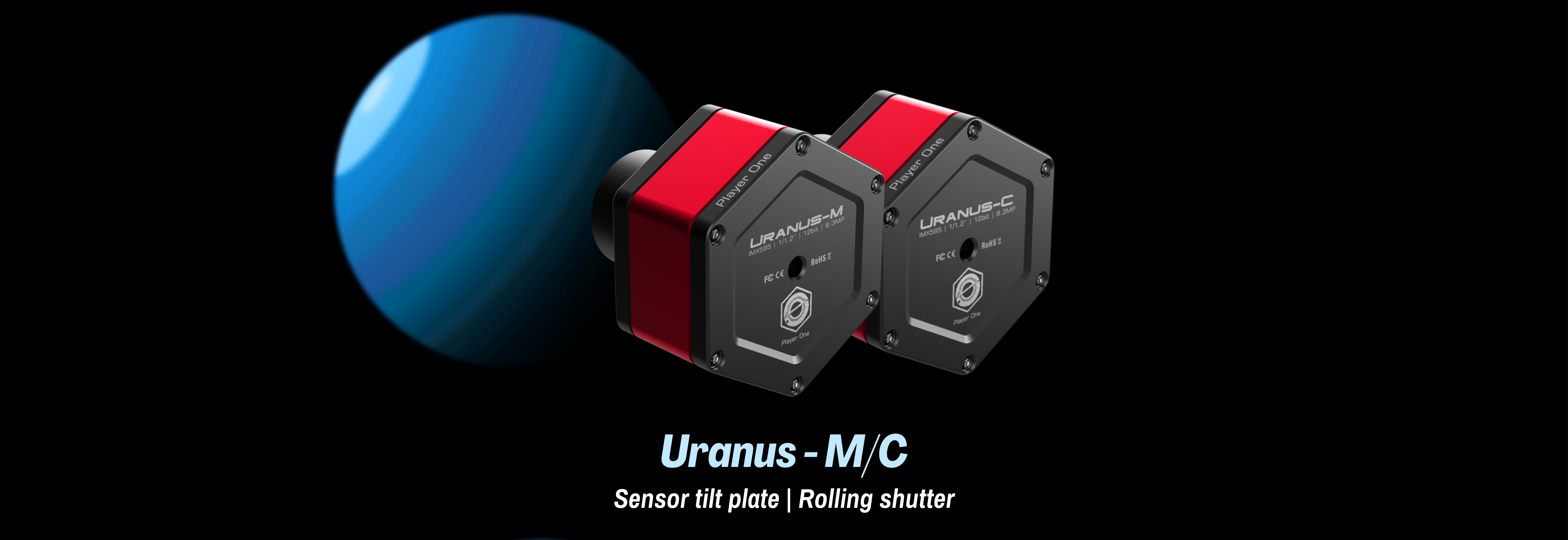
Manuals download: http://player-one-astronomy.com/service/manuals/
Manually replace the SDK manual
Product Description
Uranus-C is (IMX585) camera developed by Player One Astronomy, which adopts the newest Sony IMX585 1/1.2” format color sensor. The 2.9um pixel size accommodates a well depth of 47Ke with a total of 8.3MP (the resolution is 3856*2180), and the diagonal is 12.85mm.
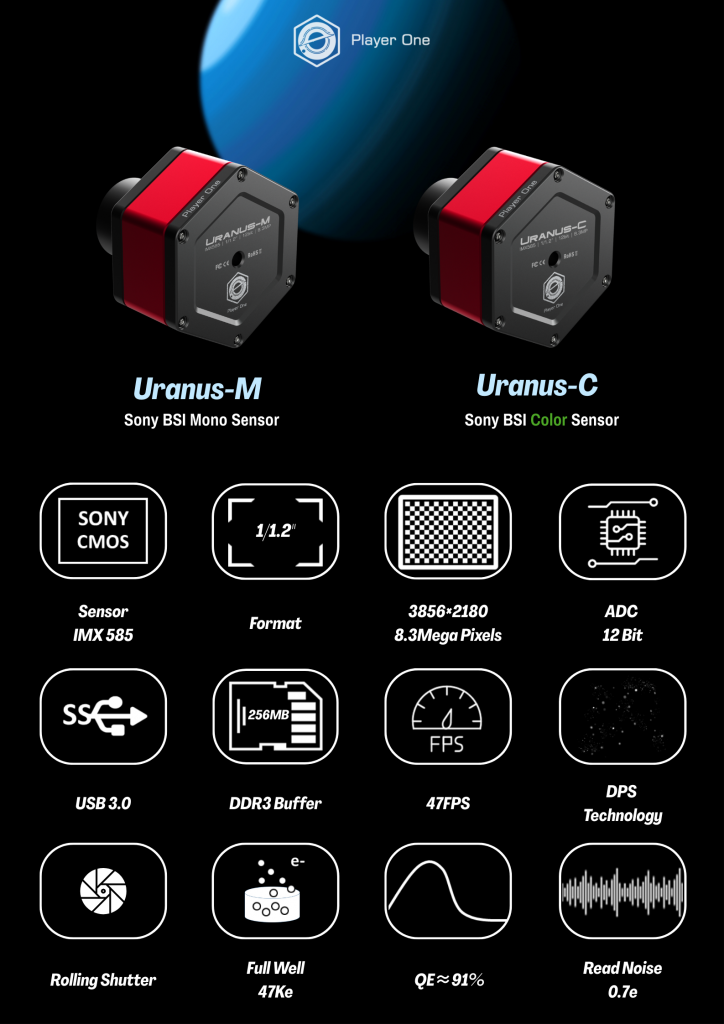
STARVIS 2 Technology
Uranus-C (IMX585) and Mars-C II (IMX662) based on Sony newest STARVIS 2 technology, it is back-illuminated pixel technology used in CMOS image sensors.
Format
Uranus-C (IMX585) has 1/1.2″ format, this size is quite big for imaging.
Full well
Uranus-C (IMX585) has 47Ke full well, it’s almost 3.6 times than IMX485 (13Ke).
Highlights
Non-Amp-Glow
Biggest supprise of Uranus-C (IMX585) camera is, its dark frame is totally “dark”, whatever we strength the curve, there is no AMP glow at all!
300s dark frame of Uranus-C camera(resize to 50%):

Non-Amp-Glow can give us very clean background, much easier to get high quaility images.
Recommended accessories:
ACS (Active Cooling System) is a external air-cooled system, designed for solar and big format planetary cameras which already has PCS (Passive Cooling System).
ACS can provide much better temperature control. When camera has PCS + ACS, temperature is only 7℃ higher than ambient, camera body is a little warm but won’t hot!
ACS is not only can be used in daylight for solar imaging, it also could be used in night for DSO lucky imaging.
https://player-one-astronomy.com/product/active-cooling-system-acs-for-uncooled-cameras/

Features:
The naming of Player One Astronomy cameras is unique. Planetary camera line, naming depend on the size of planets, Mars(1/3″), Neptune(1/2″), Uranus(1/1.2″), Saturn(1″), Jupiter(4/3″).
Drivers and softwares download: http://player-one-astronomy.com/service/software/
Manuals download: http://player-one-astronomy.com/service/manuals/
Cutting-edge Design
The planetary cameras developed by Player One Astronomy uses a scientific and technological regular hexagon to construct the main body line, supplemented by round chamfers to achieve both rigidity and flexibility. The positive red, which is like a summer fire, is matched with the low-key and steady black, and the super-fine frosting process on the entire surface makes the camera look luxurious and cool, highlighting the style of high-end players, can’t take my eyes off 😀
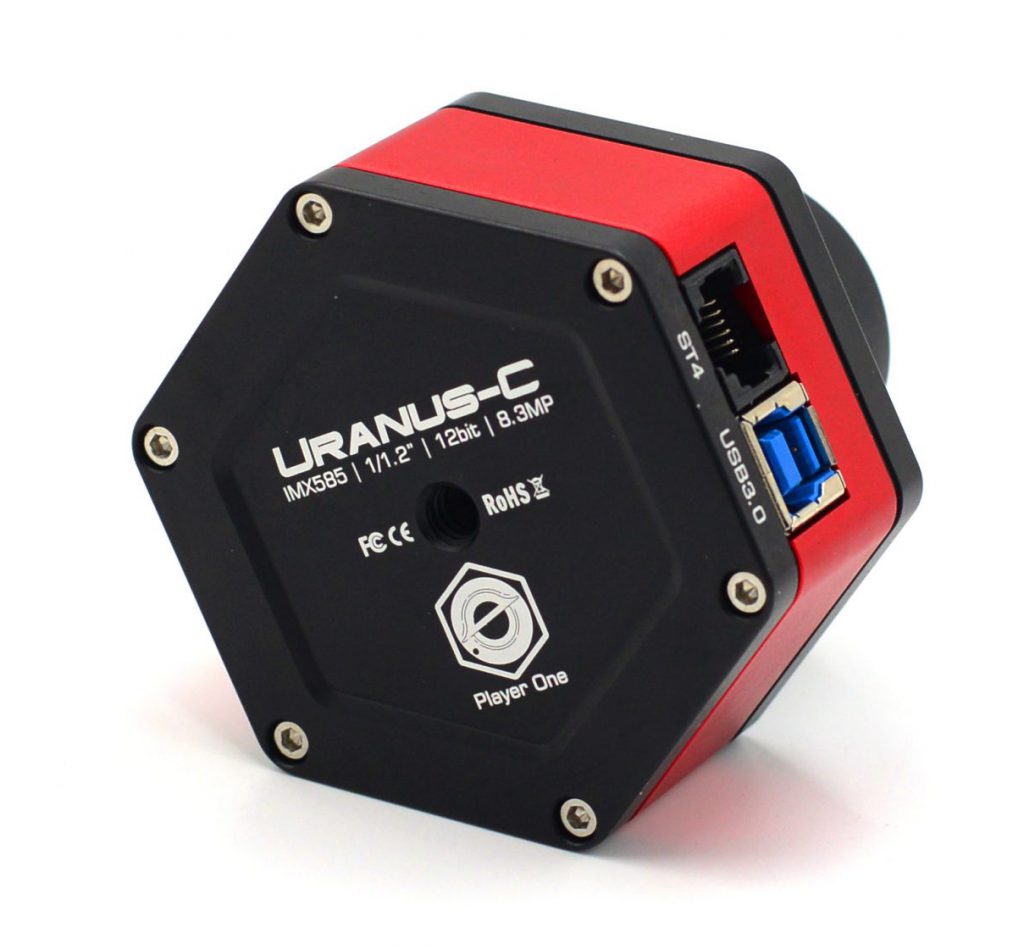
2nd Gen – Sensor Tilt Plate
When taking deepsky objects, using sensor tilt plate can get a much smaller field curvature of the telescope.
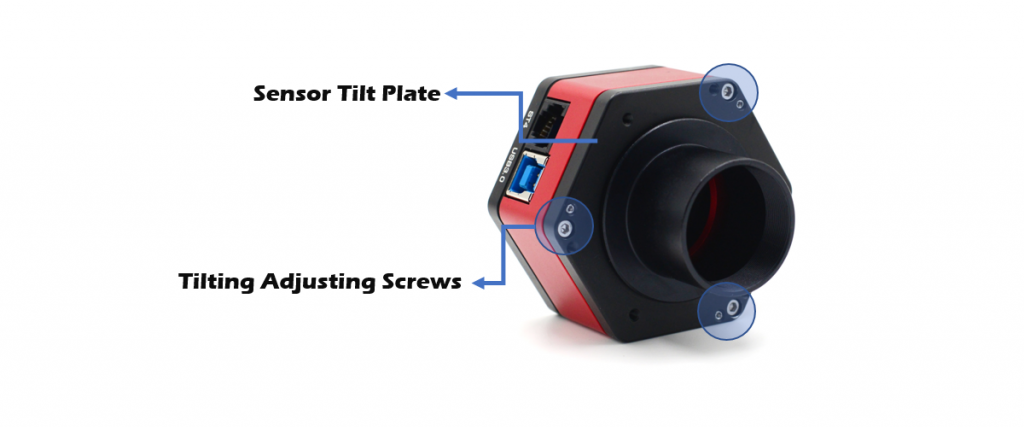
The built-in high-density sponge shading pad can block the light from the side slits without any side leakage.
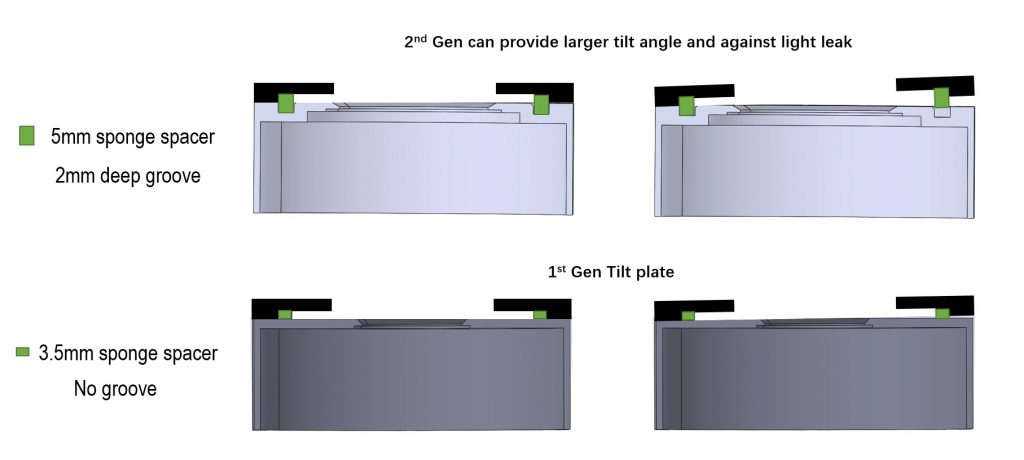
Passive Cooling System
Player One add a new feature called Passive Cooling System to conduct the heat from the sensor out.

256M DDR3 Cache
Player One Astronomy cameras are the first one who adopts the DDR3 cache in all planetary cameras in the world! It helps stabilize and secure data transmission, it effectively avoids frame dropping and greatly reduces readout noise.
With the DDR3 cache, the camera does not have high demands on computing needs any longer, it will still has excellent performance even if it is connected to a USB 2.0 port.

DPS technology
The planetary cameras from Player One Astronomy have DPS (Dead Pixel Suppression) technology. The DPS is anaylse many dark frames to find out thoes fixed abnormal pixel and record the map in camera memory. In imaging, each exposure frames, thoes position of dead pixels will be given a median value according to the active pixels around that abnormal pixel.
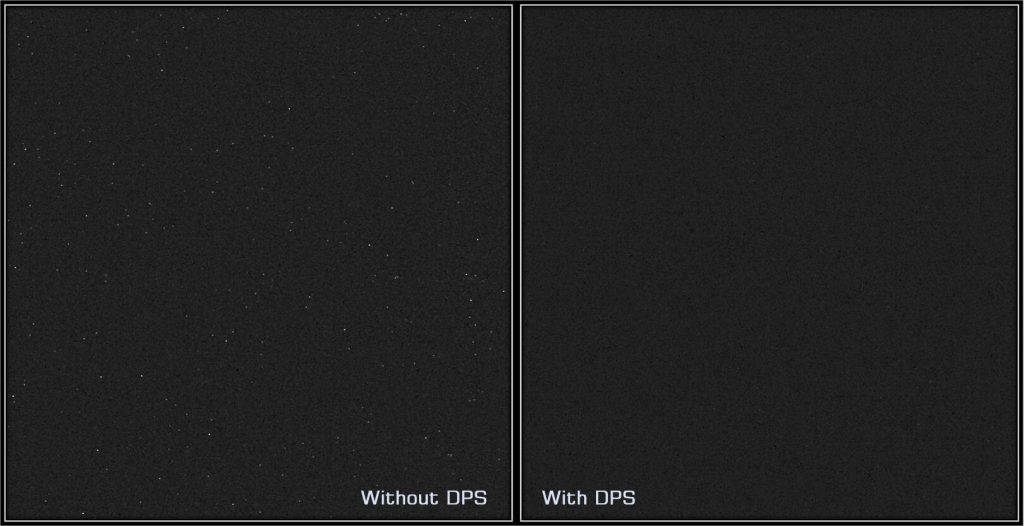
Overvoltage and overcurrent protection mechanism
Player One cameras produced by us ensures the safety of your camera and other equipment through overvoltage and overcurrent protection mechanisms.
Data Port
When the camera is connected to the USB3.0 interface and full-resolution preview is used, it can reach 47 FPS in RAW8 mode (10bit ADC). When recording images, since the actual writing speed will be affected by the writing speed of the hard disk itself, when the hard disk writing speed is slow, the recording may not reach the theoretical speed. It is recommended that you use a high-quality solid state drive to record data to give full play to the performance of the camera.
Use the ST4 guide cable to connect the camera and the AUTO GUIDE port of the equatorial mount to do guiding.
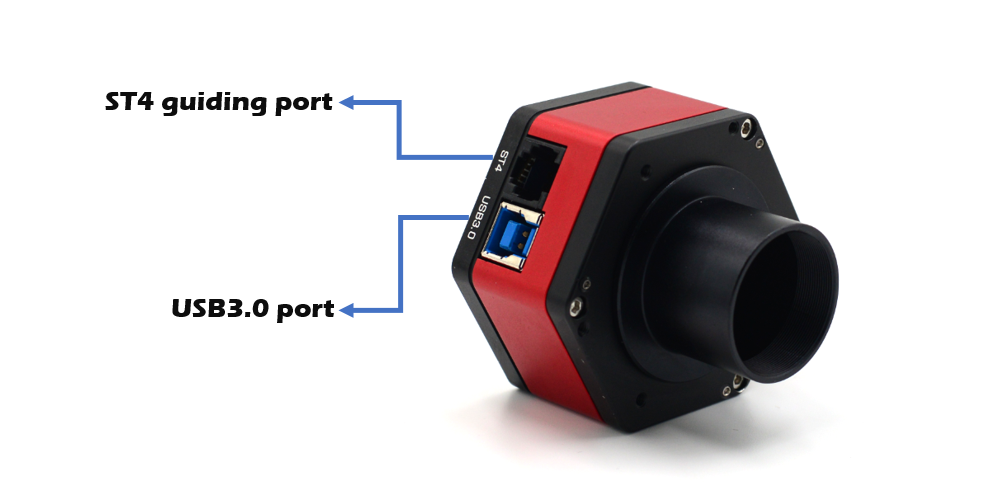
Performance
HCG open at gain=210.
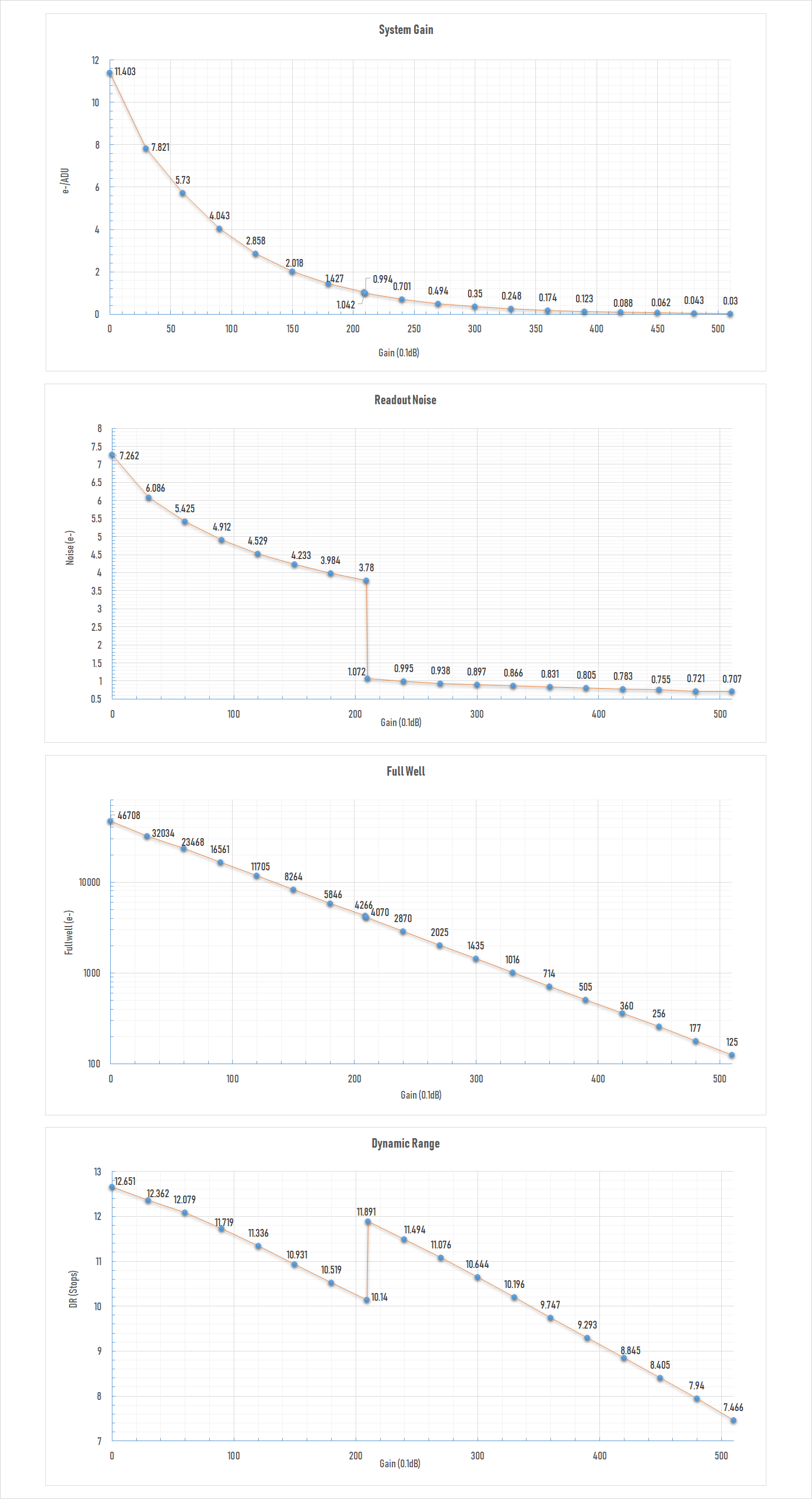
Readout Noise
Regarding readout noise, we solemnly promise that all values are obtained from actual tests. And for users, you could use Sharpcap 4 for testing. SC4 has a function called Sensor Analysis, provide a very simple way to test readout noise.
We wrote a tutorial on our website: https://player-one-astronomy.com/service/manuals/
If you are interested in readout noise testing, you may try it yourself, which is very simple.
QE Curve
This relative QE curve is provided by SONY Co., Ltd. This data is authentic and authoritative!
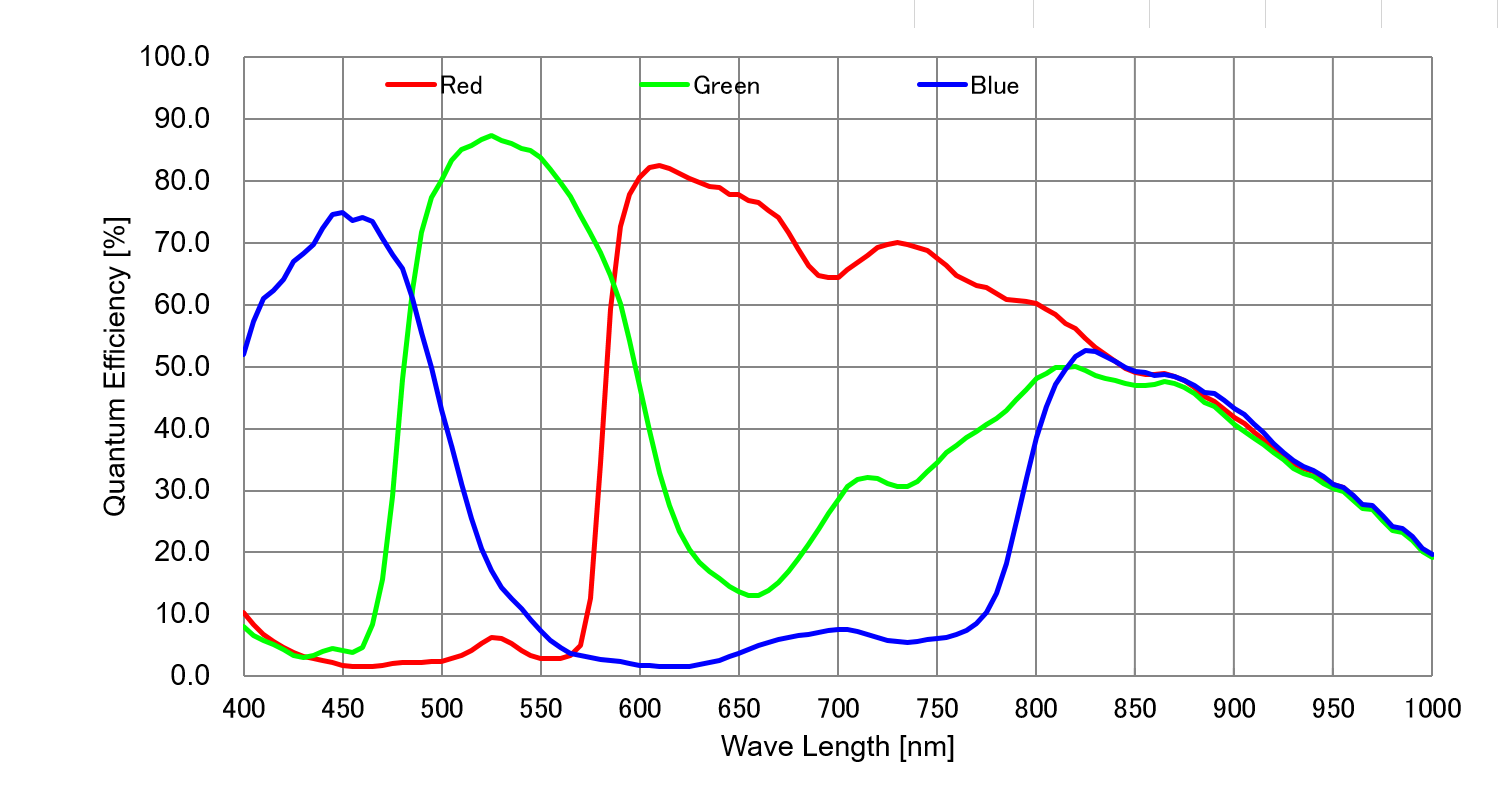
Mechanical Drawing
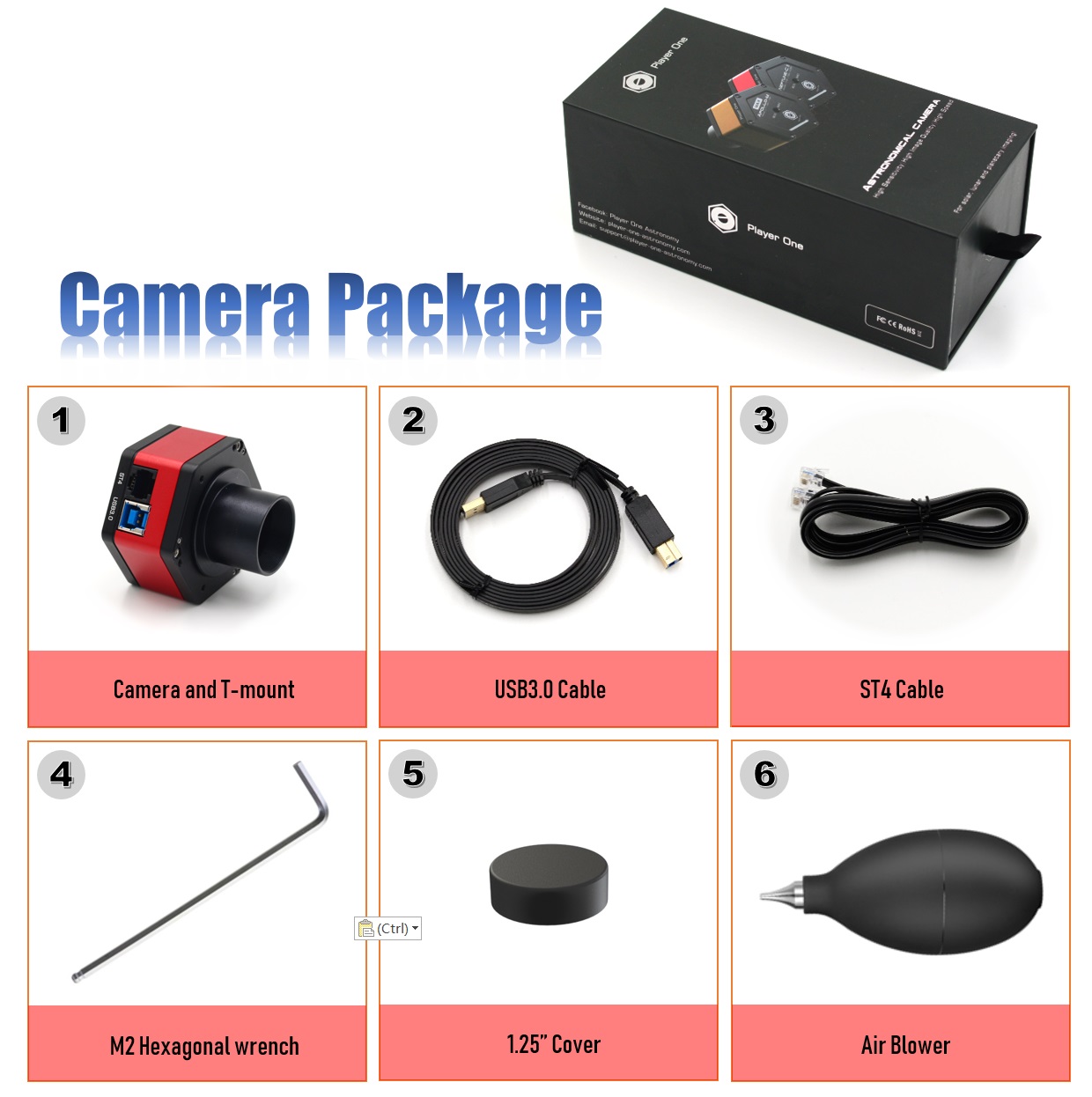
User works appreciation
Uranus-C camera also very good for lunar and planetary imaging, its 1/1.2″ big sensor can make mosaic moon more efficient.
Moon Phase- Stephane Gonza, 300mm Newtonian, Uranus-C camera

Lunar Occultation of Mars,AP92mm Refractor+ Uranus-C
-白底-small100-200x78.jpg)

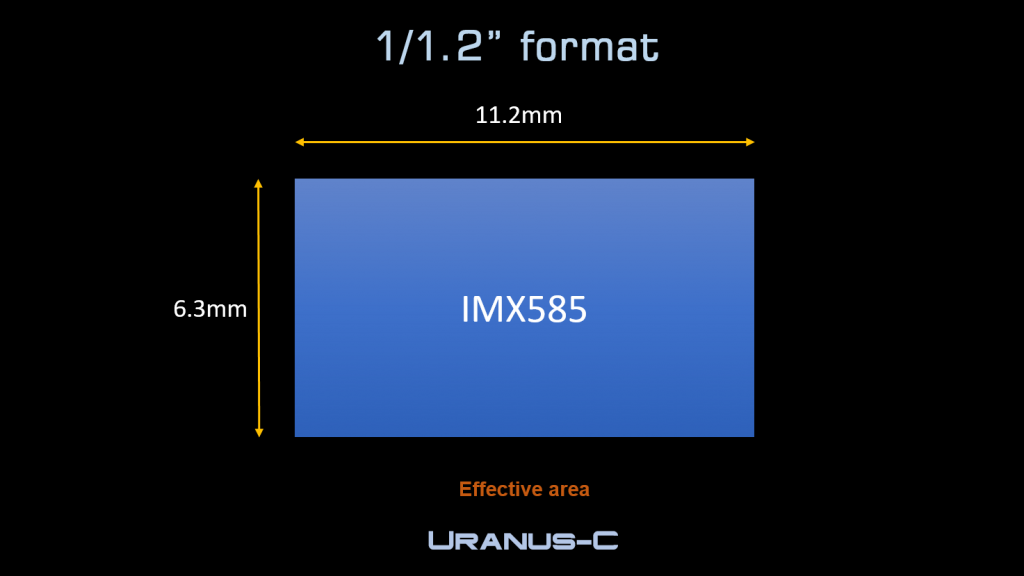

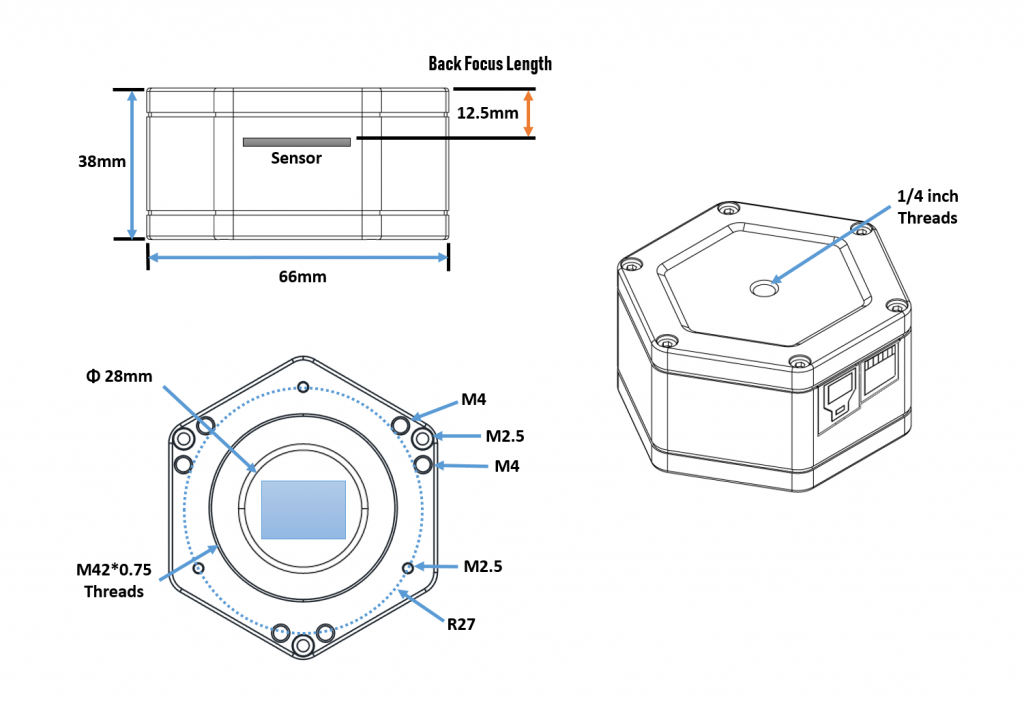
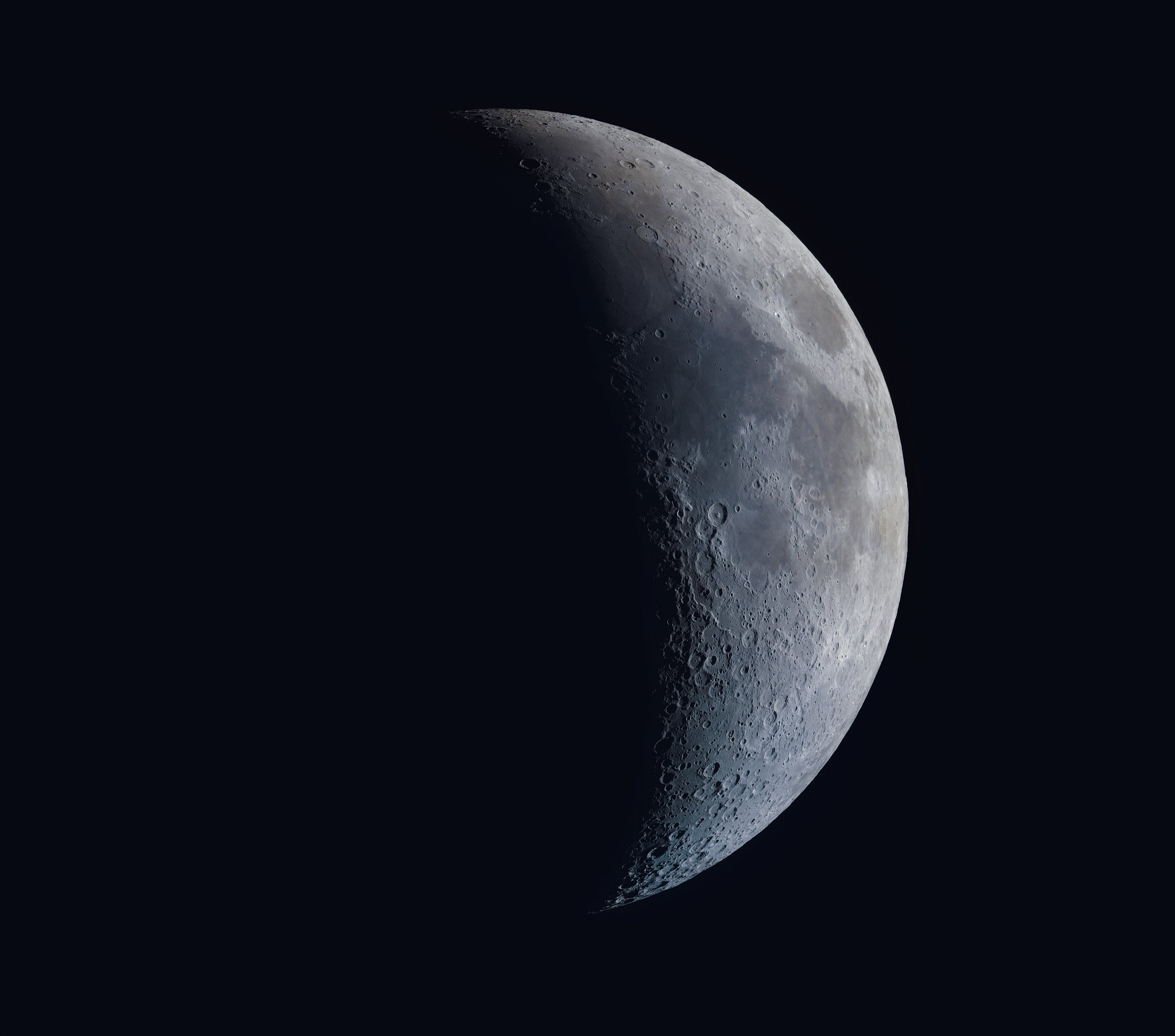
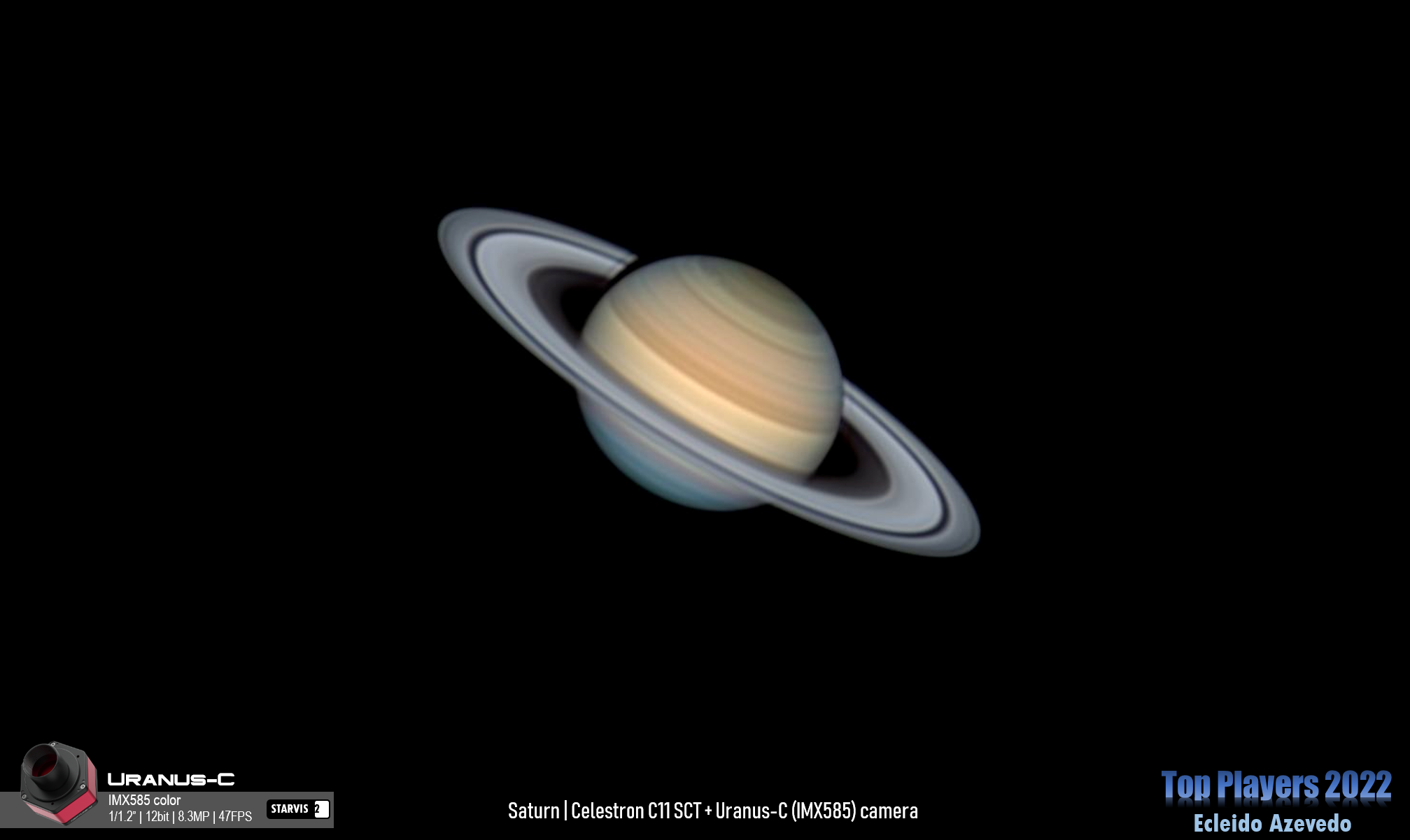

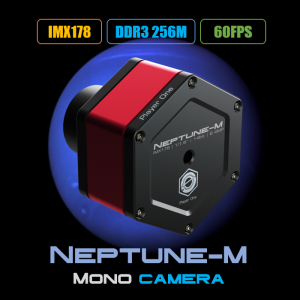
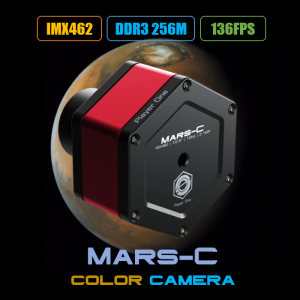
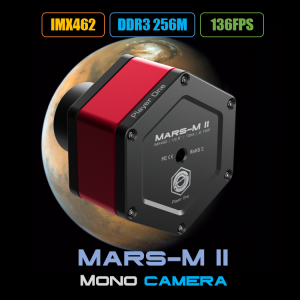
Adam Smith –
Full well is 3 times bigger than IMX485? OMG. That’s great!! I’d like to upgrade and use this 585 cam for lucky imaging.
Player One Astronomy –
That’s great, we are very glad to know you’d like to buy one 🙂
Rik Brown –
I’d like to use it for DSO lucky imaging, how long will take in shipping? I live in New York.
Player One Astronomy –
Hi Rik,
Usually will take 7-10 days after paid. Due to Cov-19, shipping time might be a little longer.
Rik Brown –
Great, I’ll put an order today!!
Player One Astronomy –
That’s great, Rik! We will send it to you asap 🙂
Adam J (verified owner) –
I tried this camera for EAA, works nice, it is very sensitive in IR. Works nice with Sharpcap. Very nice build quality 🙂
Player One Astronomy –
Thank you, Adam. It’s great to know you like the camera very much!!
Edmondo678 –
Just got my Uranus camera today, very exciting!! I’m downloading the newest driver and software, hope the weather could be clear soon. BTW, I also ordered an Saturn-M SQR cam today!!
Player One Astronomy –
Oh my! Edmondo, you ordered two new cameras in one month. 533 mono and 585 color is very good combination. Looking forward to see your first light.
Ish Ram –
Lightning-fast and high quality! I can get full chip at around 100FPS when using BIN2 mode, which is suitable for my setup. So far I have been using it for Lunar mosaics and close-ups but I look forward to some clear skies and having planets up in the evening before seeing what this colour camera is really capable of!
Buy yourself a nice, fast, large SSD to enjoy the full capabilities of this beast. Full-chip without binning saves about 380 MB/s, meaning my 512 GB disk fills up in about 20 mins.
Player One Astronomy –
Hi Ish,
Thank you so much. Uranus camera is running at top speed, SSD is the key, 🙂
Stuart Wilson (verified owner) –
Recently received my camera plus the ACS attachment and have to say I’m very impressed thus far. I’ve only had a few cloudless nights but got six hours of data with my WO Whitecat on IC1396 which looks extremely good.
Raymond Marcano –
Well I want to get the Uranus C but now the reviews scared me cause it sounds complicated and I need to learn SIMPLE BASIC first.
Jason (verified owner) –
Fantastic camera! Nearly 300fps doing planetary, and no noise to speak of with long exposure dso. With zero amp glow, I don’t even use darks anymore with it. If this is the way astro cameras are heading, extremely expensive cooled cameras could easily be replaced. If my 2600mc ever dies, I may just replace it with a newer non cooled sensor camera.
attila.seb.82@gmail.com –
Regards!
How long does it take for delivery to Hungary? and how much sooner will it arrive if I choose express delivery?
Sean Wang –
About 7-10 days! We only use Express shipping methods.
Michael –
Looks a good camera from reviews, how long will it take to ship to UK please?
Sean Wang –
Hi Michael,
About 7-10 days
Michael (verified owner) –
Fantastic camera for EAA on DSO. Produces great results with sub 30 second exposures on even dim objects, so works very well with unguided set ups. Very sensitive in IR so consider an IR cut filter (especially with refractors) to reduce star bloat and normalize color reproduction. Solid build quality. Delivery to Australia only took 10 days from China with expedited shipping.
Raphael B –
Hi, I’d like to profit from the sale to order this camera ! I live in france and I was surprised to see that the price doesnt change when I put my location, are there no taxes and shipping costs?
Sean Wang –
Hi Raphael,
We have dealer called Univers-Astro in France, buy from them will be best way!
miyarui1013 (verified owner) –
Ordered! Can’t wait for it to arrive!
Graides –
Hello, I like this camera.I’d like to use it for planetary imaging, how long will take in shipping? I live in Lithuania
Sean Wang –
About 7-10 days!
Fin –
Hey there, how long would shipping to the United Kingdom take?
Sean Wang –
Hi Fin,
About 7-10 days!
Flavio Cicero (verified owner) –
fantastic customer service, fantastic camera. Great support when my camera had a factory problem, resolved within a week with a replacement part. Far better than ZWO, Touptek, and QHY.
CL6X –
This has to be the best camera i will ever have, its so affordable, yet it yeilds such good results, it pulls structure from M81 in 30s exposures, and Player-One made sure to ship it early because they knew i had a clear night, love yall.
CL6X –
i love. ty for shipping early
Abhijit Dasgupta (verified owner) –
Excellent Camera! I have the uncooled version and using it for widefield DSO imaging with great results. My very first DSO images exceeded my expectations: I imaged six targets over three days, each 10 minutes (60 subframes at 10secs each, tracked but unguided, 40mm aperture F4.5 lens, camera gain 360, ambient ~22C). All of them turned out to be great. For capture software, I used EKOS/INDI under linux, and the camera works very well with the linux INDI drivers. Player One customer service was fantastic too! Before buying, I had some questions and they immediately answered all my queries. Highly recommended camera and company!
astrofilipaternesi@gmail.com –
The best astronomical camera I have owned up to now, exceptional on the planetarium but also on the deep sky, extremely high-performance, solid and versatile in use, it works excellently with SharpCap 4.1 and with N.I.N.A. I will be upgrading my cameras very soon by purchasing a Mars-CII and Artemis-C Pro and Uranus-C Pro. Compliments.
Léo Duchêne (verified owner) –
Great camera, with even for deep sky imaging without cooling (I live in a cold place).
Is it possible to activate a mono bin function with this camera? I know it is possible with some other color cameras from different manufacturers but could not see the option in sharpcap. Maybe with a driver update?
Sean Wang –
Hi Leo, Sharpcap need to update to 4.1 version.